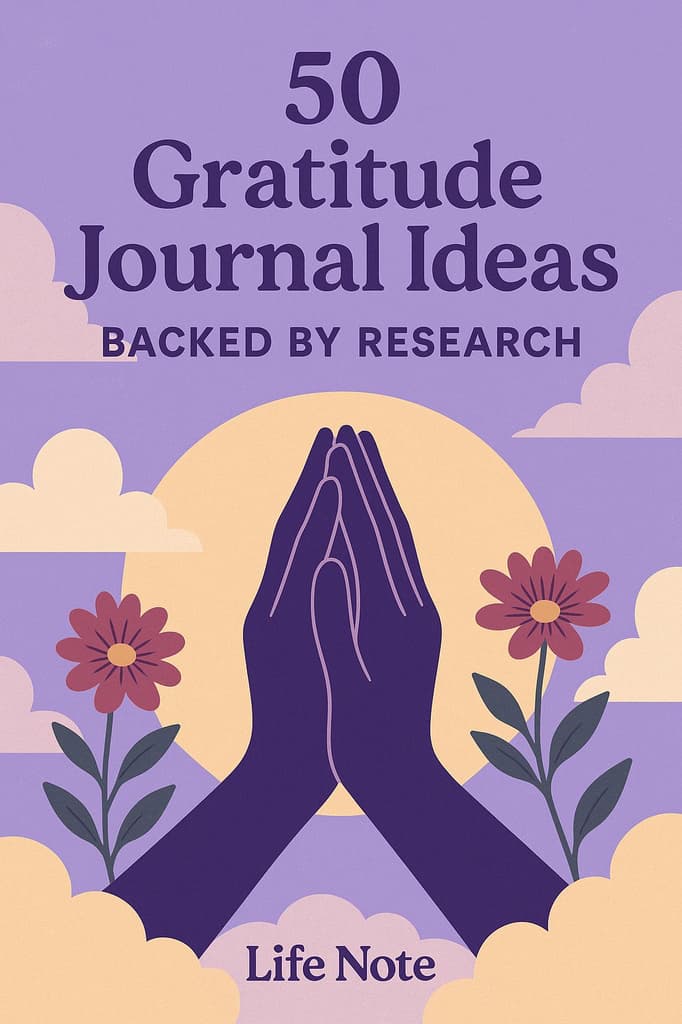Gratitude Journaling Prompts: The Antidote to Modern Dissatisfaction
Learn grateful journaling with our complete guide to gratitude journaling for beginners — plus 10 science-backed gratitude journaling ideas to start today.

Introduction: The Quiet Epidemic of “Not Enough”
Almost everyone today carries a quiet sense that life should be better.
You should be more successful, more confident, more fulfilled. Your relationships should be deeper, your days more meaningful. This chronic dissatisfaction is not an individual failing — it’s the emotional architecture of the modern world.
Every feed we scroll, every ad we see, whispers the same message:
“You could be more.”
We’ve built an economy on self-comparison. Pop culture tells us that anything short of a dream job, perfect body, and soulmate means we’re falling behind. And when we don’t measure up, we don’t just feel disappointed — we feel defective.
But neuroscience and positive psychology are starting to reveal something quietly radical: you don’t need to fix everything in your life to feel fulfilled. You need to see differently.
That’s where grateful journaling — the intentional practice of writing what you appreciate — comes in. It’s not another trend; it’s one of the most studied and validated mental habits for rewiring the human brain toward contentment, connection, and resilience.
1. Why Gratitude Is Hard (and Why It Matters More Than Ever)
Your brain was never built for happiness — it was built for survival.
From an evolutionary standpoint, dissatisfaction was useful. Early humans who noticed threats and lacked complacency survived better than those who were blissfully content. The problem is that our modern environment exploits this ancient circuitry.
In the past, noticing danger kept you alive.
Today, it keeps you scrolling.
The result is hedonic adaptation — the human tendency to normalize gains and quickly return to a baseline of wanting more. You get the promotion, the apartment, the partner… and within months, it feels ordinary again.
Gratitude interrupts this cycle. It’s the cognitive act of saying:
“I already have enough, right now.”
That single shift — from absence to abundance — changes how your nervous system perceives life.
2. Gratitude as Evolutionary Glue
Gratitude didn’t appear because philosophers invented it. It evolved because it helped us survive.
Anthropologists trace its roots to reciprocity — a biological mechanism encouraging cooperation. When one primate shared food or grooming, both brains lit up with reward chemicals, reinforcing trust and alliance. Over time, this instinct shaped human tribes into cooperative societies.
Today, the same emotional architecture fires when you write “I’m grateful my friend listened to me today.” The act of acknowledgment activates the same neural circuitry that once helped your ancestors build social bonds strong enough to survive winter.
Gratitude is not abstract. It’s an ancient operating system for belonging.
3. The Science of Gratitude: Your Brain on Appreciation
When you engage in grateful journaling, three key brain regions light up:
- Prefrontal cortex – linked to emotional regulation and perspective.
- Nucleus accumbens – the brain’s reward center, releasing dopamine.
- Anterior cingulate cortex – involved in empathy and motivation.
This network strengthens over time, making gratitude a trainable skill.
Studies from UC Davis and the University of Miami found that those who journaled gratitude just 3 times a week reported:
- 25% more optimism
- Better sleep and lower stress hormones
- Stronger immune responses
- Reduced symptoms of depression and burnout
In neuroscience terms, gratitude is emotional weightlifting. Every repetition — every line in your gratitude journal — reinforces new neural pathways that make appreciation more automatic.
4. Why Traditional Journaling Fails (and How to Fix It)
If journaling has failed you before, it’s not because you’re lazy. It’s because most systems were never designed for how human motivation works — especially in an overstimulated world.
To stay consistent, any reflective habit needs four psychological drivers:
- Interest – Is it personally meaningful or novel?
- Urgency – Does it feel time-sensitive or emotionally important?
- Novelty – Does it change enough to keep the brain curious?
- Accountability – Is someone or something keeping you engaged?
This is why so many blank notebooks gather dust. They don’t engage your dopamine system. The key to sustainable gratitude journaling for beginners is to gamify the experience — make it playful, dynamic, and rewarding in itself.
For instance:
- Try a visual gratitude board with sketches or photos.
- Exchange entries with a friend once a week.
- Use an AI-guided app like Life Note that adapts prompts to your reflections.
Gratitude, when made engaging, becomes self-reinforcing.
5. Gratitude as Emotional Recalibration
Anxiety, envy, and cynicism are signals of imbalance, not character flaws. They arise when the brain’s threat circuits dominate its appreciation circuits.
Gratitude rebalances that system. It reduces cortisol, increases serotonin, and helps the prefrontal cortex override fear-driven responses from the amygdala. It’s not about ignoring pain — it’s about contextualizing it.
Dr. Glenn Fox, a leading neuroscientist studying gratitude, describes it as “a mental lens that transforms ordinary experiences into sources of joy.”
Or as the poet G.K. Chesterton put it:
“The test of all happiness is gratitude.”
6. How to Practice Gratitude: For Skeptics and Beginners
If you’re new to gratitude journaling, start with realism, not perfection. The goal isn’t to feel grateful all the time — it’s to build awareness.
Here’s a simple structure used in positive psychology research:
- Set aside 5–10 minutes, 2–3 times a week.
- List 3–5 things you’re grateful for. Be specific. (“My morning walk in the rain,” not “nature.”)
- Write why it matters. What emotion or value does it represent?
- Visualize the moment again. Re-activate the feeling.
That’s it. This simple act, done consistently, can rewire your emotional baseline within weeks.
If writing feels too static, try voice journaling — speak your thoughts aloud into your phone. ADHD and neurodivergent users often find verbal gratitude more natural than written formats.
7. 10 Powerful Gratitude Journaling Ideas (Backed by Psychology)
These prompts are arranged from simple reflection to deep cognitive reframe. Each one is evidence-based and designed to increase emotional flexibility, empathy, and well-being.
1. What went right today?
Train your brain to notice micro-successes: a smile, an idea, a peaceful moment.
2. Who made my day easier (and how)?
Social gratitude strengthens empathy and belonging — both core predictors of happiness.
3. What problem do I no longer have?
A reminder that progress often hides in what’s no longer painful.
4. What small comfort do I take for granted?
Running water, working Wi-Fi, mobility — the mundane is miraculous in perspective.
5. What recent fear didn’t come true?
Gratitude dismantles catastrophic thinking by exposing your brain’s false alarms.
6. What did I learn from discomfort this week?
Transform adversity into insight. Every frustration carries a lesson.
7. Who do I need to thank but haven’t?
Write or text them. Expressed gratitude multiplies benefits.
8. What kindness did I witness today?
Observing others’ generosity activates mirror neurons — you feel their goodness.
9. What about my past self am I grateful for?
Revisit past decisions that made your present life possible.
10. What is enough, right now?
End each session by defining sufficiency — the most radical form of gratitude.
If you’re looking for a structure, start with the first three prompts for a week. Gradually expand into the deeper ones as reflection becomes more natural.
8. The Gratitude Feedback Loop
In evolutionary terms, gratitude was built to create positive reciprocity.
In psychological terms, it creates feedback loops that reinforce emotional resilience.
- Gratitude → calm → connection → gratitude again.
This loop often begins subtly. You start noticing small kindnesses. People respond to your warmth. The world feels less hostile. Your perspective changes — not because circumstances improve, but because attention shifts.
Gratitude doesn’t make life easier; it makes life larger.
9. Common Obstacles in Gratitude Practice
Even the best gratitude journaling ideas won’t work if you turn them into perfectionist checklists. Here’s what to watch for:
1. Repetition fatigue:
Writing “friends, family, health” weekly numbs the effect. Use new details.
2. Forced positivity:
If you’re grieving or angry, acknowledge it. Gratitude grows out of truth, not denial.
3. Inconsistency:
It’s okay to miss days. Focus on rhythm, not streaks. Gratitude compounds, not resets.
4. Over-analysis:
You don’t have to feel deep gratitude every time you write. Sometimes, showing up is enough.
10. How Gratitude Rewires Behavior
In behavioral economics studies, participants who practiced gratitude were more patient, generous, and less impulsive with money and food choices.
Why? Because gratitude expands your time horizon.
When you feel content in the present, you stop chasing immediate fixes. You make calmer, more ethical decisions. Gratitude literally teaches your brain to prefer meaning over dopamine.
This is why grateful journaling quietly transforms careers, relationships, and health — not through discipline, but through perception.
11. Gratitude in the Face of Hardship
True gratitude isn’t fragile optimism. It’s forged in contrast.
People recovering from illness or trauma often describe a phenomenon called post-traumatic growth — a renewed appreciation for small things. The sunlight feels warmer. Food tastes richer. Laughter lands deeper.
What changed wasn’t the world — it was the frame. Gratitude reframes survival into awe.
If gratitude feels out of reach, start small:
- “I’m grateful I’m still trying.”
- “I’m grateful for one person who cares.”
- “I’m grateful this pain will not last forever.”
You don’t need to feel grateful to practice gratitude. The act itself creates the emotion.
12. Gratitude Journaling for Beginners: How to Start Today
If you’ve never journaled before, here’s a simple path:
Step 1 – Choose your medium:
Notebook, phone notes, or AI journal — whatever feels frictionless.
Step 2 – Anchor it:
Pair journaling with an existing habit. Example: after morning coffee or before bed.
Step 3 – Pick 1–3 prompts per session:
Rotate between simple and deep ones. Avoid lists that feel mechanical.
Step 4 – Reflect weekly:
Look back at past entries. Notice patterns and progress.
Step 5 – Keep it real:
Write honestly — even if you feel numb. Gratitude grows from awareness, not performance.
This is gratitude journaling for beginners at its best: simple, flexible, and human.
13. Life Note: The Modern Gratitude Companion

At Life Note, we’ve built a journaling experience designed around how real humans — not productivity robots — process emotion.
Our AI mentors draw from timeless wisdom (Marcus Aurelius, Maya Angelou, Carl Jung) to guide reflection and uncover patterns in your writing. It’s grateful journaling reimagined for the 21st century: adaptive, personalized, and gentle.
Here’s what makes it powerful for gratitude journaling:
- Dynamic prompts evolve based on your entries, avoiding repetition fatigue.
- Pattern recognition shows emotional shifts over time.
- Mentor reflections help you connect gratitude with personal growth.
- Weekly insights highlight recurring themes — so you can see what nourishes your well-being.
Because gratitude isn’t just something you write. It’s something you live into.
14. Extended FAQ: Gratitude Journaling for Real People
1. How can journaling help with gratitude and happiness?
Grateful journaling helps externalize positive memories and counteract negativity bias. When you put appreciation into words, it strengthens your emotional memory. Studies show journaling gratitude just three times a week can improve long-term happiness and reduce stress.
2. What is gratitude journaling for beginners?
It’s a simple reflective exercise where you list and describe things you’re thankful for — people, experiences, sensations, or even lessons. For beginners, start small: one line a day about what went right or who helped you. Over time, your entries deepen naturally.
3. What are some easy gratitude journaling ideas?
- “One good thing that happened today was…”
- “Someone I appreciate is…”
- “A challenge that taught me something was…”
- “Something beautiful I noticed was…”
Rotate prompts to keep novelty alive — your brain craves variation.
4. How is grateful journaling different from a regular diary?
A diary records events. A gratitude journal reframes perception. Instead of venting or listing to-dos, you practice active appreciation, which has measurable psychological benefits.
5. Can gratitude journaling replace therapy?
No. Gratitude journaling supports emotional health but isn’t a substitute for professional care. It can complement therapy by enhancing self-awareness and emotional resilience.
6. How long before gratitude journaling makes a difference?
Most people report shifts in mood within 2–4 weeks of consistent practice. Brain imaging studies show long-term neural changes after 10–12 weeks.
7. What if I can’t feel gratitude when I write?
Write anyway. Focus on describing neutral facts first (“I have a bed,” “I had food today”). Emotional depth often follows reflection. Gratitude is a muscle — not every rep feels powerful, but every rep builds strength.
8. How often should I journal gratitude?
Ideally 3–4 times a week. Overdoing it daily can dull sensitivity. Think of gratitude as seasoning — sprinkle often, not obsessively.
9. Can gratitude journaling help with ADHD or anxiety?
Yes. Research shows structured reflection reduces cognitive overload and promotes focus. Gratitude journaling provides emotional grounding for restless or anxious minds.
10. What tools can help me stay consistent?
Use apps like Life Note, which provide adaptive gratitude journaling prompts, reminders, and AI reflections to sustain motivation. Or join group challenges for accountability.
References
- Emmons, R. A., & McCullough, M. E. (2003). Counting blessings versus burdens: Gratitude and subjective well-being.
- Fox, G. R. et al. (2015). Neural correlates of gratitude. Frontiers in Psychology.
- DeSteno, D. (2014). Gratitude: A Tool for Reducing Economic Impatience. Psychological Science.
- Seligman, M. E. P. (2011). Flourish: A Visionary New Understanding of Happiness.
- Watkins, P. C. (2014). Gratitude and the Good Life: Toward a Psychology of Appreciation.
Conclusion: Gratitude as a Way of Seeing
In a world built to amplify dissatisfaction, gratitude is an act of rebellion. It doesn’t demand perfection, only presence.
Each journal entry — each quiet acknowledgment of what is good — becomes a thread pulling you back to reality.
Gratitude journaling isn’t about becoming happier. It’s about remembering you already have reasons to be.
Write them down.
Read them back.
That’s how you reprogram the brain — and reclaim your peace.
Explore More Content






